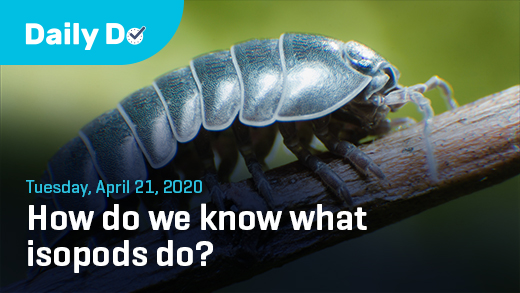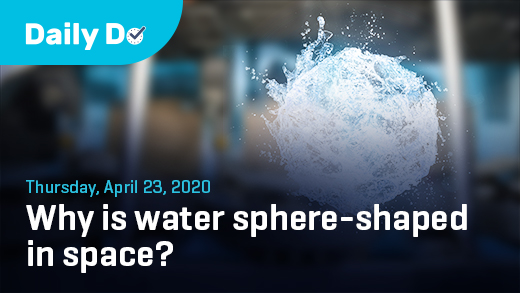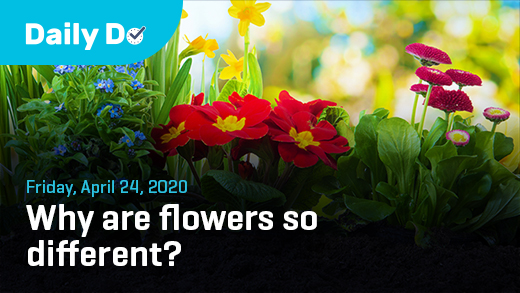Reflecting on This Week’s Daily Do
By Korei Martin
Posted on 2020-04-26

Introduction
Our last weekend in April. Many of you have been providing opportunities for students to do science through distance and home learning for as many as four weeks. Before reading further, pause for just a moment to reflect on one win you experienced this week (whether you credit yourself or serendipity) that excites and inspires you to do it again next week.
We’ve shared an elementary and secondary vignette in which students-as-scientists engaged in science and engineering practices to make sense of intriguing natural phenomena (observable events that occur in the universe and that we can use our science knowledge to explain or predict). This week, we’re going to focus on one of the eight science and engineering practices: Developing and Using Models.
[Models] serve the purpose of being a tool for thinking with, making predictions and making sense of experience. (A Framework for K-12 Science Education, p 56)
Let’s look at the practice of Developing and Using Models in the context of Why is water sphere-shaped in space? In the lesson this task is adapted from (designed prior to the NGSS), students over-fill a cup with water, drop by drop, and do the same with a penny. They notice the surface of the water is dome-shaped and “piled” higher than the rim of the cup/penny. Students are then provided the explanation. Now compare this to students sensemaking in the Why is water sphere-shaped in space? task. Students experience a puzzling phenomenon on the International Space Station (ISS) – water squeezed from a pouch forms a sphere that can hold candy on the surface. They make and share observations and then are asked to create an initial model that explains (a how or why account of) the phenomenon.
Imagine the prior knowledge and experience students might bring to their models:
I’ve seen water form big drops on our windshield. We put something on it that repels water.
I spilled water lots of times and it doesn’t make drops, but we dropped water on wax paper at school and pushed it around.
I’ve seen water striders walk on water and when they move the water sort of bounces back.
I know it’s called surface tension.
Some raindrops get really big, sometimes you can see they’re big but sometimes you can just feel it.
Students use their prior knowledge, experience and observations to try to explain the phenomenon using words, pictures, and symbols (models serve the purpose of being a tool to think with).
Imagine, next, that the blank piece of paper is daunting and students don’t know how to begin or are fearful of making a mistake. Although there are specific knowledge and skills that make up the practice of Developing and Using Models at each grade band – called elements (bulleted points listed under each grade band) – all students’ models independent of grade band need to include:
- Components (relative parts)
- Interactions (how the components are related or interact)
To support struggling students, you might ask, “What absolutely has to be included (components) in a model that explains why the water formed a sphere that can hold candy on the surface?” Students would likely say water and candy. Some students might add water molecules, air, and gravity (or lack of gravity). Once students have represented their components on paper, you could ask, “How do these components (point to two components) interact? What moves? What changes?”
Models serve the purpose of making sense of experiences. In creating their models, students realize they have gaps in their knowledge. (“You know, I don’t know why the water is a sphere.”) Students’ have questions they are motivated to answer. The teacher uses these questions to navigate students to the next investigation, “Many of us are wondering if this could happen on Earth, does it make sense to start there?” The next day, students conduct an investigation using the dropper, cup and penny to make sense of the cohesive property of water. (Students return to their models later in the task, but for time and space we’ll leave the story here.)
What resonates with you as you compare the role of students in the original lesson with the sensemaking task? Who has access to the science ideas in each scenario? Why? Which scenario leads to ownership of science ideas? Why?
Before we meet next week, consider reading the vignette in the (free) “Developing and Using Models” chapter (pp 109-110) from Helping Students Make Sense of the World Using Science and Engineering Practices. In this vignette, fifth-grade students are creating models to explain how and why evaporation occurs – a piece of the puzzle needed to figure out how solar stills work to clean dirty water. Students are revising their models at the midpoint of the unit. (Of course, you are welcome to read the entire chapter!)
Below you’ll find descriptions of every Daily Do published this week. As you visit each Daily Do or reflect on one you taught during the week, can you identify the science and engineering practice(s) students engage with to make sense of the phenomenon (or science ideas)? Can you identify the element(s) of the science and engineering practice?
Monday, April 20, 2020 – Why Does Some Food Disappear?

In today’s Daily Do, Why does some food disappear?, students engage in science and engineering practices and use patterns as a thinking tool to make sense of the phenomenon of digesting a graham cracker. Students have an opportunity to apply physical science ideas about chemical reactions and physical changes to develop life science ideas about digestion (the beginning of the science idea the body is a system of multiple interacting systems). This task has been modified from its design to be used by students, families, and teachers in distance learning. While students could complete this task independently, we encourage students to work virtually with peers or in the home with family members.
Tuesday, April 21, 2020 – How Do We Know What Isopods Do?

Did you ever wonder about the roly-polies (also known as sow bugs and pill bugs) you find outside when you turn over a rock over or rake away damp leaves? Maybe you’ve even seen a few in your garage or house. In turns out these roly-polies are terrestrial isopodswhich are related to shrimp and lobsters! Although, maybe you’re not too surprised based on their looks.
In today’s task, How do we know what isopods do?, students and their families engage in science and engineering practices to begin to make sense of the science idea animals have external structures that serve various functions in growth, survival and behavior while becoming more familiar (and hopefully less fearful) of terrestrial isopods.
Today’s task is based on activities by Dr. Ron Wagler published in the NSTA Blog “What Are These Bugs Under the Log? Home-Based Science With Terrestrial Isopods.”
Wednesday, April 22, 2020 – How Are They Similar and Different?

Even if plants and animals are the same kind, can they still be distinguished from each other? Today’s task is inspired by the NSTA eBook Are They the Same? The story follows the journey of Speck, a red-spotted newt, who encounters many different kinds plants and animals on his search for a new pond to become his winter home. How didn’t he notice before how different individual plants and animals can be even when they’re the same kind of plant and animal?!
In this task, How are they similar and different?, students and their families read the NSTA eBook Are They the Same? and engage in analyzing and interpreting data (science and engineering practice) and use the thinking tool of patterns (crosscutting concept) to make sense of a big idea in science – individuals of the same kind of plant or animal are recognizable as similar but can also vary in many ways.
Thursday, April 23, 2020 – Why Is Water Sphere-Shaped In Space?

 Did you know humans have been living in space for the last 20 years? NASA is currently celebrating the Year of Recognition, highlighting the anniversary of 20 years of continuous human presence aboard the International Space Station on November 2nd, 2020.
Did you know humans have been living in space for the last 20 years? NASA is currently celebrating the Year of Recognition, highlighting the anniversary of 20 years of continuous human presence aboard the International Space Station on November 2nd, 2020.
Fluids – gasses and liquids – are everywhere in our lives. The Earth, known as “the water planet,” is able to support life in part because of the presence of water. Understanding the basic principles of fluid motion such as with water, is important for all walks of life. The behavior of water on the International Space Station (ISS) is not only mesmerizing and beautiful to observe (see picture below), researchers are using these observations to figure out why fluids behave differently in micro-gravity than they do on Earth. The near-weightless conditions aboard the station allow researchers to observe and control a wide variety of fluids in ways that are not possible on Earth. Understanding how fluids react in these conditions could lead to improved designs for space travel, as well as back on Earth.
In today’s task, Why is Water Sphere-Shaped in Space?, students and their families engage in science and engineering practices to make sense of the phenomenon of liquid water forming a perfect sphere-shape in space. Students see how the science ideas that explain water’s sphere-shape in space are applied to the design of the Space Coffee Cup and then brainstorm solutions to other problems astronauts encounter that will help people live in space! While students could complete this task independently, we encourage students to work virtually with peers or in the home with family members.
Friday, April 24, 2020 – Why Are Flowers So Different?

When we look around we can see many different types of flowers. Have you ever wondered why? In today’s task, Why are flowers so different?, students and their families engage in science and engineering practices and use the thinking tool of structure and function (crosscutting concept) to make sense of the science ideas that some plants depend on animals for pollination and have specialized features for reproduction.
This activity is adapted for online learning from the California Academy of Sciences lesson: Flowers Seeking Pollinators curated by NGSS@NSTA Connection.

